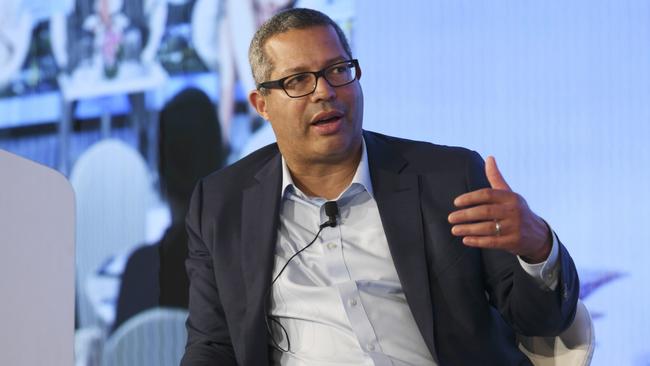US economy on track for soft landing, says Morgan Stanley chief economist Seth Carpenter
Morgan Stanley’s chief global economist sees encouraging parallels between the current US economic outlook and the situation it faced almost 30 years ago.

History may be littered with the wreckage of soft landing attempts but Seth Carpenter sees encouraging parallels between the current US economic outlook and the cycle of the mid-1990s.
That was the last time the Fed managed to contain inflation without causing a recession.
But like the current cycle, the mid-1990s also featured a longer than usual expansion combined with disinflation, which allowed the Fed to cut interest rates. Morgan Stanley’s chief global economist is convinced that cooling inflation will allow the Fed to start cutting interest rates in September.
A former assistant secretary for financial markets at the US Treasury, Mr Carpenter spent 15 years at the Fed, where, as deputy director in monetary affairs, he was closely involved in the formulation of quantitative easing after the Global Financial Crisis.
But unlike the mid-1990s when the Fed cautiously cut the funds rate three times from September 1995 to March 1996, then went on hold as the unemployment rate remained at what was then considered to be a relatively low level of around 5 per cent, Mr Carpenter sees the Fed cutting seven times through to the end of 2025, by which time he expects inflation to be near 2 per cent.
“One thing that is curious is that they only cut 75 basis points back then,” Mr Carpenter tells The Australian. “It’s remarkable to note that when they pulled off that soft landing, and then waited for a while, inflation actually kept falling and ended up running one and a half per cent after a while.
“So in fact, they could have been more accommodative, they could have spent more time thinking where the boundaries were, in terms of how low they could go with the Fed funds rate and how much expansion they could get from the economy.”
Mr Carpenter will brief clients on his views at Morgan Stanley’s Australia Summit next month.
After its latest policy meeting, the Federal Open Market committee noted that there had been “a lack of further progress” toward its 2 per cent inflation target in recent months.
The FOMC said it “does not expect it will be appropriate to reduce the target range until it has gained greater confidence that inflation is moving sustainably toward 2 per cent”.
But based on the lessons from the mid-1990s, Mr Carpenter thinks the FOMC can gain the requisite “confidence” in inflation falling back to the target even while unemployment remains low.
“I do think that’s one difference in the Fed’s mindset now versus then,” he says.
“They’ve changed their strategic framework, to sort of say, ‘okay, we want to fight against employment shortfalls, but we’re no longer as worried as we used to be about unemployment being too low, because who knows, who knows how low the unemployment rate can go’.”

If inflation is clearly under control as he expects it will be in the second half, he sees “room to let the economy find its legs and see how far it can run”.
The Fed’s own forecasts peg the long-run unemployment rate – essentially the natural rate of unemployment – in a range of 3.5 to 4.3 per cent, not far above the latest level of 3.9 per cent.
Housing inflation comprises 40 per cent of core CPI and 18 per cent of core personal consumption expenditure inflation, so wherever housing inflation goes, the whole index will likely follow.
Mr Carpenter points out that the Bureau of Labour Statistics takes current rents and essentially spreads those price changes over a couple of quarters. Current readings on rents have been very weak, so a continued fall in the official statistics for the rest of the year seems clear.
Of course there remains some concern in financial markets that inflation could be underpinned by structural forces like de-globalisation, de-carbonisation and resource scarcity. But Mr Carpenter argues that one-time cost increases won’t necessarily cause a sustained period of high inflation.
“It doesn’t mean that we’re necessarily in a new decade where inflation is higher,” he says.
“If people say we’re in a higher inflation environment because we used to be running around 1.8 per cent and now we’re going to be at 2.1 per cent (by the end of 2025), in that case, fine.
“The Fed will be very happy with that kind of outcome … they were wringing their hands for a long time about inflation being too low for too long.”
As for the risk of major fiscal stimulus limiting the potential for interest rate cuts after the Presidential election, Mr Carpenter says that risk is “real” but depends on the structure of Congress.
“To do a big fiscal package, you need to have control over both houses of the Congress and the White House, so that means either a red sweep where the Republicans win control of the entire federal government, or a blue sweep where the Democrats win control of the government.”
He notes the Republicans’s big priority in the past decade has been tax reform and when Donald Trump was president that was delivered in the so-called Tax Cut and Jobs Act.
“Some of the components of the tax cuts are set to expire, so I think you can count on in that scenario, tax cuts overall – extending the tax cuts that were put in place before and possibly doing some additional tax cuts on corporate taxes, and then there probably is some additional spending that would want to get done, possibly with the military,” Mr Carpenter says.
In that scenario he sees fiscal expansion, more spending, lower taxes, and a budget deficit to GDP ratio of around 3.5 per cent versus 6.3 per cent in 2023.
In a blue sweep he expects the big priorities will continue to be around the green energy transition and infrastructure, yet he also suspects Democrats would look to raise taxes to some extent by letting some of the provisions of the tax cut and job act expire.
“They would want to raise taxes on corporations and so you would probably get less of a fiscal expansion under a blue wave than under a red wave, but either one of those would sort of keep the rise in the debt to GDP ratio probably going up, not down.
“Historically, if we look back over the past 30-40 years, the periods of time where you’ve had the biggest fiscal consolidation have been when there’s a Democrat in the White House and Republicans controlling the Congress,” he adds.








To join the conversation, please log in. Don't have an account? Register
Join the conversation, you are commenting as Logout